Photovoltaic Roofing for Motorways and Other High-Ranking Road Networks: Technical Feasibility, Yield Estimation, and Final Demonstrator
Abstract
1. Introduction
2. PV-SÜD Concept
2.1. Supporting Structure Constraints
- Energy generation through photovoltaics based on suitable PV module technology;
- Utilization of existing sealed street areas;
- Flexible use in the high-level road network;
- Flexible integration with minimum yield variety for different sites and geographical orientation;
- Increase the durability of the roadway by protecting against overheating and precipitation;
- Positive effects on road surface properties.
- The canopy structure had to be easily adaptable to the existing road layout.
- The design of the basic geometry should be optimized for power generation, aesthetics, and road operation requirements.
- The design in terms of geometry, length, and cross-section should be in such a way that no rules and regulations for tunnel structures have to be mandatorily applied.
- The supporting structure should be designed in such a way that no system failure can occur in the exceptional load case of fire or impact.
2.2. PV Systems Constraints
- The PV solution should be scalable on highways with two and three lanes with and without a shoulder and should be duplicable, i.e., not require a site-specific special solution.
- Regular commercially designed products should be preferred versus specially designed solutions.
- The energy generation should be optimized and maximized with regard to the structural conditions, i.e., the entire covered area should be used by PV if possible, excluding openings for lighting or ventilation.
- Energy generation should be as independent as possible from the direction of travel of the roadway (north–south (N-S), or east–west (E-W), etc.) due to the type of construction and structural solution.
- Facilities should be constructed to eliminate or minimize self-shading.
2.3. Evaluation of Different Geometric Shapes
2.4. PV-SÜD Concepts
3. Results
3.1. Yield Sensitivity of PV-SÜD
- ASFINAG Rastplatz Leobersdorf A2,
- A1 Raststation St. Pölten SÜD,
- A2 Klagenfurt am Wörthersee,
- Parken mit WC-Anlage “Brandbühl” an der B 33 (Radolfzell am Bodensee, LK Konstanz),
- Park and Ride Anlage Engen an der A 81 (Engen, LK Konstanz),
- Petrol and Ride Anlage Hegau an der A 81 (Engen, LK Konstanz),
- Hamburg Seevetal, Rastplatz Sunderblick A1,
3.2. Results for the Demonstration Site (Hegau)
3.3. Realization of PV-SÜD Demonstrator (Hegau)
3.3.1. PV Module Used for the PV-SÜD Demonstrator
- General Module Data: Vision 60 M construct.
- Module technology: Glass-glass laminate, aluminum frame, black.
- Covering material: Tempered solar float glass 2 mm, anti-reflective finish.
- Encapsulant: Solar cells in polymer encapsulation, transparent.
- Backing material: Tempered float glass, 2 mm.
- Solar cells: 60 monocrystalline high-power PERC solar cells, 157 mm × 157 mm.
- Module dimensions: L × W × H/Weight: 1.680 ± 2 × 990 ± 2 × 40 ± 0.3 mm/weight: appr. 22.8 kg
- Protection class: II (acc. to IEC 61140).
- Fire class: A (acc. to IEC 61730/UL 790), E (acc. to EN 13501-1), BROOF (t1) (acc. to EN 13501-5).
- Certified mechanical ratings as per IEC 61215: Suction load up to 2.400 Pa (test load 3.600 Pa), Pressure load up to 5.400 Pa (test load 8.100 Pa).
3.3.2. Inverter Used for the PV-SÜD Demonstrator
3.3.3. Vibration Test of the PV-SÜD Demonstrator
4. Conclusions
Author Contributions
Funding
Data Availability Statement
Conflicts of Interest
References
- IRENA. World Energy Transitions Outlook 2023: 1.5 °C Pathway; International Renewable Energy Agency: Abu Dhabi, United Arab Emirates, 2023; Volume 1, Available online: www.researchgate.net/publication/350636989_WORLD_ENERGY_TRANSITIONS_OUTLOOK_-_15C_PATHWAY#fullTextFileContent (accessed on 1 August 2024).
- IEA-PVPS. Snapshot of Global PV Markets 2023. Report IEA-PVPS T1-44:2023. Available online: https://iea-pvps.org/snapshot-reports/snapshot-2023 (accessed on 1 August 2024).
- Wirth, H.; Eggers, J.B.; Trommsdorff, M.; Neuhaus, H.; Heinrich, M.; Wieland, S.; Schill, C. Potenziale der Integrierten Photovoltaik in Deutschland. In Proceedings of the 36. PV-Symposium, Pforzheim, Germany, 18–26 May 2021; Available online: https://freidok.uni-freiburg.de/data/224889 (accessed on 1 August 2024).
- Ebner, R.; Mayr, C.; Rennhofer, M.; Berger, K.A.; Heinrich, M.; Basler, F.; Beinert, A.J.; Huyeng, J.D.; Haider, M.; Prammer, D.; et al. PV Roofing for High Ranking Road Networks: Technical Feasibility and Yield Estimation. In Proceedings of the WCPEC-8, Milan, Italy, 26–30 September 2022. [Google Scholar]
- Huyeng, J.D.; Forster, J.; Basler, F.; Romer, P.; Beinert, A.J.; Schill, C.; Heinrich, M.; Neuhaus, D.-H.; Wirth, H. Technical Aspects for Road Integrated Photovoltaics Towards a More Sustainable Mobility Sector. In Proceedings of the WCPEC-8, Milan, Italy, 26–30 September 2022. [Google Scholar]
- Hrapović, K. Photovoltaics—Highway Roofing. Int. J. Multidiscip. Res. Publ. (IJMRAP) 2022, 4, 91–95. [Google Scholar]
- Jiang, H.; Lu, N.; Qin, J.; Yao, L.; Lian, X.; He, J.; Liu, T.; Zhou, C. Roofing Highways with Solar Pannels substantially reduces Carbon Emission and Traffic Losses. Earth’s Future 2024, 12, e2023EF003975. [Google Scholar] [CrossRef]
- SWISS ENERGYPIER. 2 Planned Demonstrator Plants in Switzerland. Available online: https://energypier.ch/pages/projects#pilot_project_fully (accessed on 1 August 2024).
- Mikovits, C.; Schauppenlehner, T.; Scherhaufer, P.; Schmidt, J.; Schmalzl, L.; Dworzak, V.; Hampl, N.; Sposato, R.G. A Spatially Highly Resolved Ground Mounted and Rooftop Potential Analysis for Photovoltaics in Austria. ISPRS Int. J. Geo-Inf. 2021, 10, 418. [Google Scholar] [CrossRef]
- Fechner, H. Ermittlung des Flächenpotentials für den Photovoltaik-Ausbau in Österreich: Welche Flächenkategorien sind für die Erschließung von besonderer Bedeutung, um das Ökostromziel realisieren zu können. Study for Austria’s Energy. 2020. Available online: https://oesterreichsenergie.at/fileadmin/user_upload/Oesterreichs_Energie/Publikationsdatenbank/Studien/2020/PV-Studie_2020.pdf (accessed on 1 August 2024).
- Desai, A.; Kanika; Patel, C.R. The impact of electric vehicle charging infrastructure on the energy demand of a city. Energy Rep. 2023, 9, 814–823. [Google Scholar] [CrossRef]
- Drakulić, M.; Brandt, R.; Borchiellini, R.; Del Ray, I.; Dix, A.; Fresta, M.; Harvey, N.; Huijben, H. Design Fire Characteristics for Road Tunnels, Technical Committee 3.3; 2017R01EN; World Road Association (PIARC): La Défense, France, 2017. [Google Scholar]
- Pirringer, S. Brandberechnung von Stahlbetontunnels- Eine Gegenüberstellung; Diplomarbeit TU Wien, Institut für Tragkonstruktionen: Vienna, Austria, 2008. [Google Scholar]
- ÖNORM EN 13501-5:2016 11 01; Klassifizierung von Bauprodukten und Bauarten zu ihrem Brandverhalten—Teil 5: Klassifizierung mit den Ergebnissen aus Prüfungen von Bedachungen bei Beanspruchung durch Feuer von außen. DIN: Berlin, Germany, 2016.
- ÖNORM EN 1793-5:2019 02 15; Lärmschutzvorrichtungen an Straßen—Prüfverfahren zur Bestimmung der akustischen Eigenschaften—Teil 5: Produktspezifische Merkmale—In-situ-Werte der Schallreflexion in gerichteten Schallfeldern. DIN: Berlin, Germany, 2019.
- Beinert, A.J.; Romer, P.; Heinrich, M.; Mittag, M.; Aktaa, J.; Neuhaus, D.H. The Effect of Cell and Module Dimensions on Thermomechanical Stress in PV Modules. IEEE J. Photovolt. 2020, 10, 70–77. [Google Scholar] [CrossRef]
- IES 61140:2016; Protection against Electric Shock—Common Aspects for Installation and Equipment. IEC: Geneva, Switzerland, 2016.
- IEC 61215-1:2021 Edition 2.0 (2021-02-23); Terrestrial Photovoltaic (PV) Modules—Design Qualification and Type Approval—Part 1: Test Requirements. IEC: Geneva, Switzerland, 2021.
- IEC 61215-2:2021 Edition 2.0 (2021-02-24); Terrestrial Photovoltaic (PV) Modules—Design Qualification and Type Approval—Part 2: Test Procedures. IEC: Geneva, Switzerland, 2021.
- IEC 61730-1:2016 Edition 2.0 (2016-08-17); Photovoltaic (PV) Module Safety Qualification—Part 1: Requirements for Construction. IEC: Geneva, Switzerland, 2016.
- IEC 61730-2:2016 Edition 2.0 (2016-08-18); Photovoltaic (PV) Module Safety Qualification—Part 2: Requirements for Testing. IEC: Geneva, Switzerland, 2016.
- UL 790 Edition 9-2022; Standard Test Methods for Fire Tests of Roof Coverings (Building Integrated Photovoltaics -BIPV products only). UL Standards & Engagement: Evanston, IL, USA, 2022.
- IEC 61701:2020; Photovoltaic (PV) modules—Salt mist corrosion testing. IEC: Geneva, Switzerland, 2020.
- IEC 62804-1-1:2020 Edition 1.0; Photovoltaic (PV) Modules -Test Methods for the Detection of Potential-Induced Degradation – Part 1-1: Crystalline Silicon—Delamination. IEC: Geneva, Switzerland, 2020.
- IEC 62716:2013 Edition 1.0; Photovoltaic (PV) Modules—Ammonia Corrosion Testing. IEC: Geneva, Switzerland, 2020.
- Prammer, D.; Vorwagner, A.; Berger, K.; Lachinger, S.; Lechner, A. Green New Deal: Neue baudynamische Herausforderungen für PV-Überdachungen über Autobahnen. In 17. D-A-CH Tagung; 2021; Available online: https://sgeb.ch/userdata/uploads/pdf/dokumentationen/tagungsband-d-a-ch-2021.pdf (accessed on 1 August 2024).
- Assmus, M.; Jack, S.; Weiss, K.A.; Koehl, M. Measurement and simulation of vibrations of PV-modules induced by dynamic mechanical loads. Prog. Photovolt. Res. Appl. 2011, 19, 688–694. [Google Scholar] [CrossRef]
- Weninger-Vycudil, A.; Simanek, P.; Haberl, P.; Rohringer, T. Handbuch Pavement Management in Österreich; Straßenforschungsheft Nr. 584; Bundesministerium für Verkehr, Innovation und Technologie BMVIT: Wien, Germany, 2009. [Google Scholar]
- Bettin, M.; Maurer, R.; Bach, A. Anprall gegen Pfeiler von Bestandsbauwerken. Brückenkolloquium 2020, 4, 531–544. Available online: https://elibrary.narr.digital/article/99.125005/kbr202010531 (accessed on 1 August 2024).
- ÖNORM EN 1991-2:2012 03 01; Eurocode 1: Einwirkungen auf Tragwerke—Teil 2: Verkehrslasten auf Brücken (Konsolidierte Fassung). DIN: Berlin, Germany, 2012.
- ÖNORM B 1991-2:2018 08 01; Eurocode 1—Einwirkungen auf Tragwerke—Teil 2: Verkehrslasten auf Brücken—Nationale Festlegungen zu ÖNORM EN 1991-2 und Nationale Ergänzungen. DIN: Berlin, Germany, 2018.
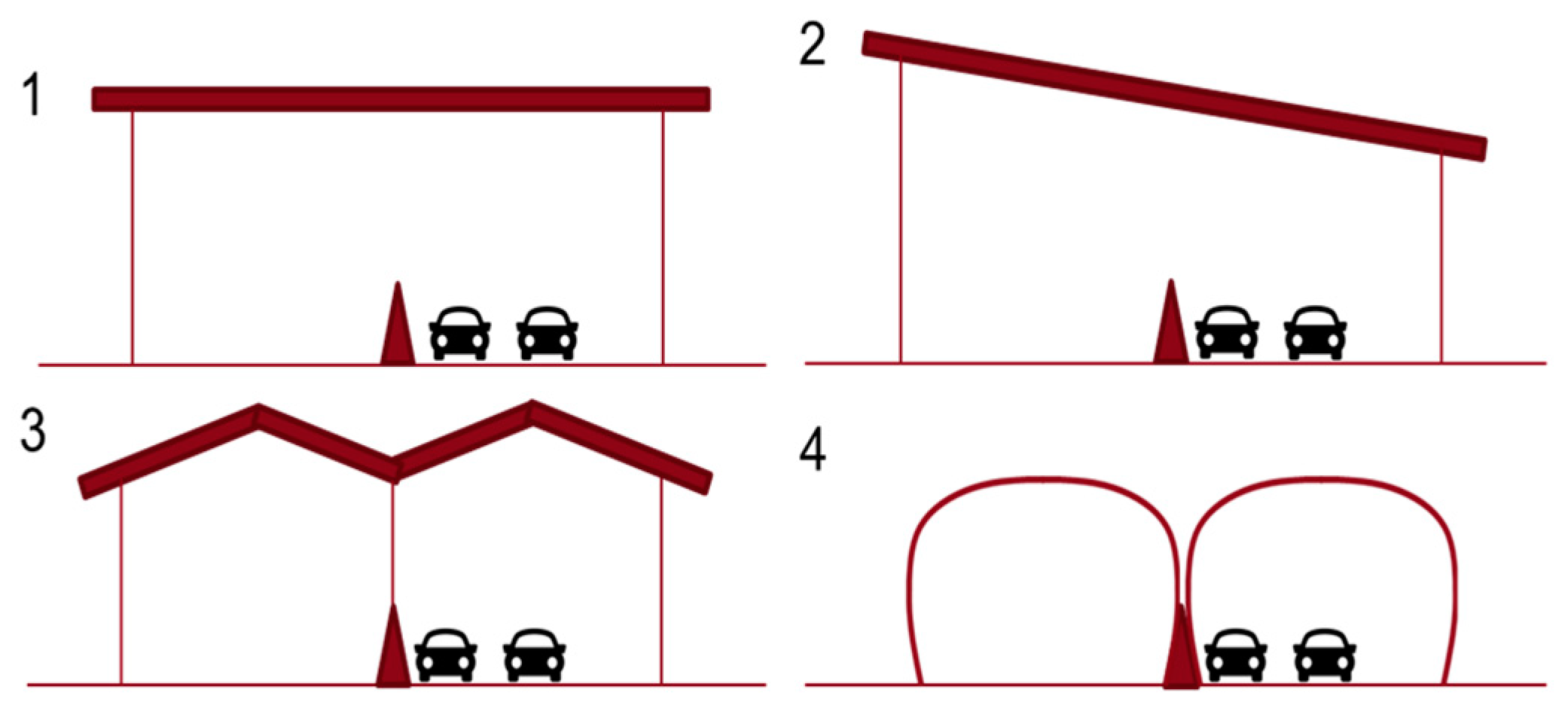
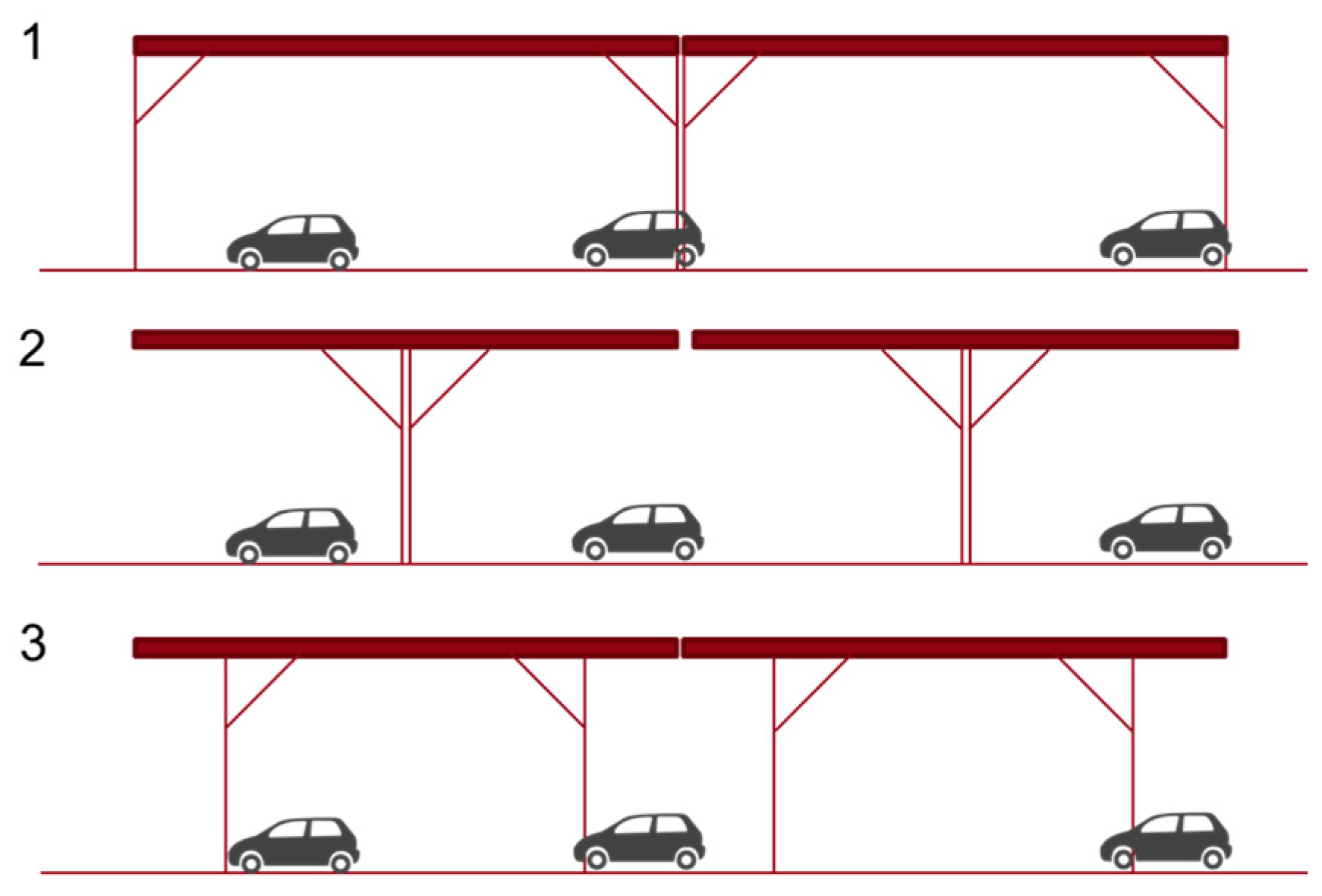


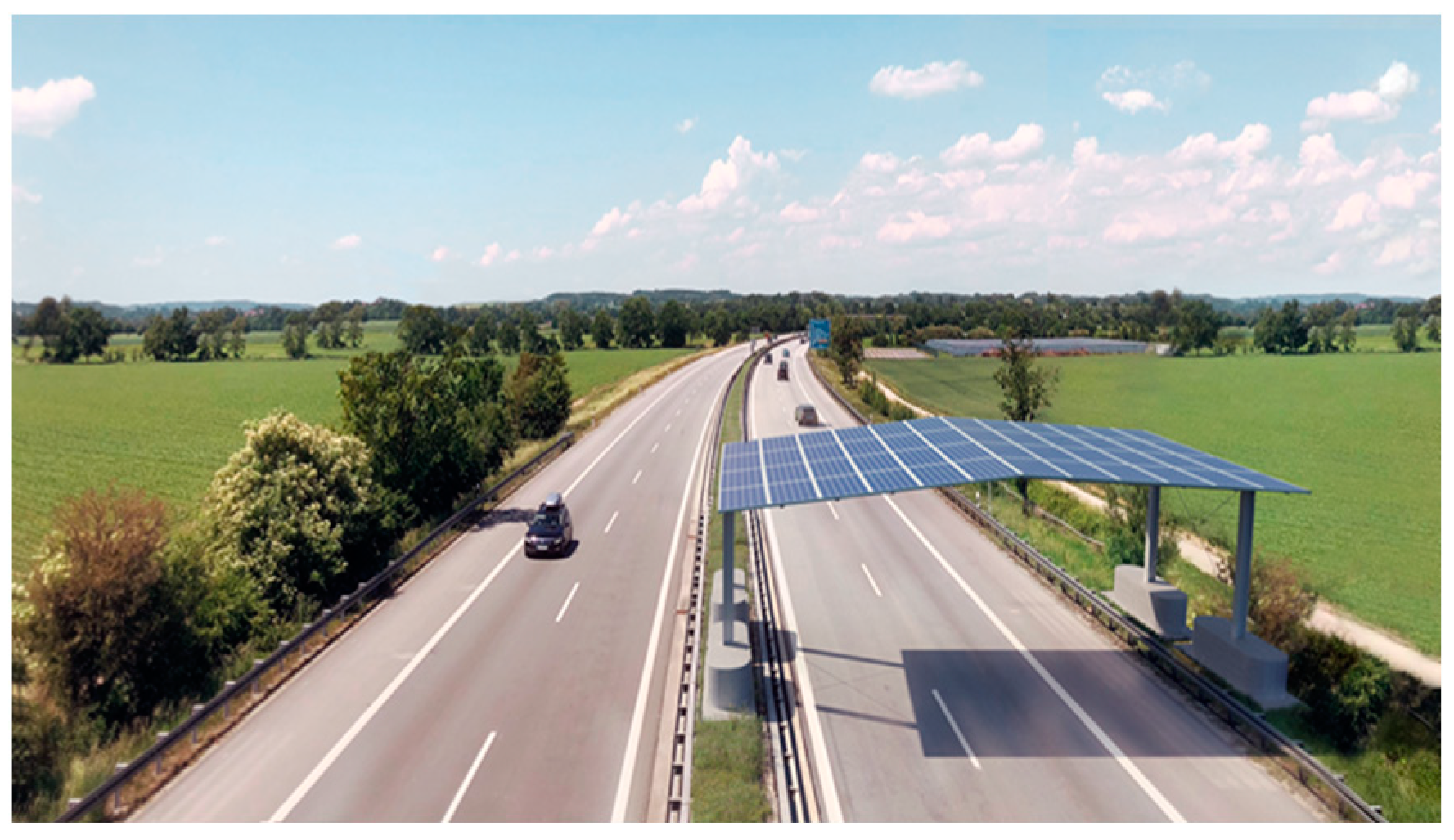
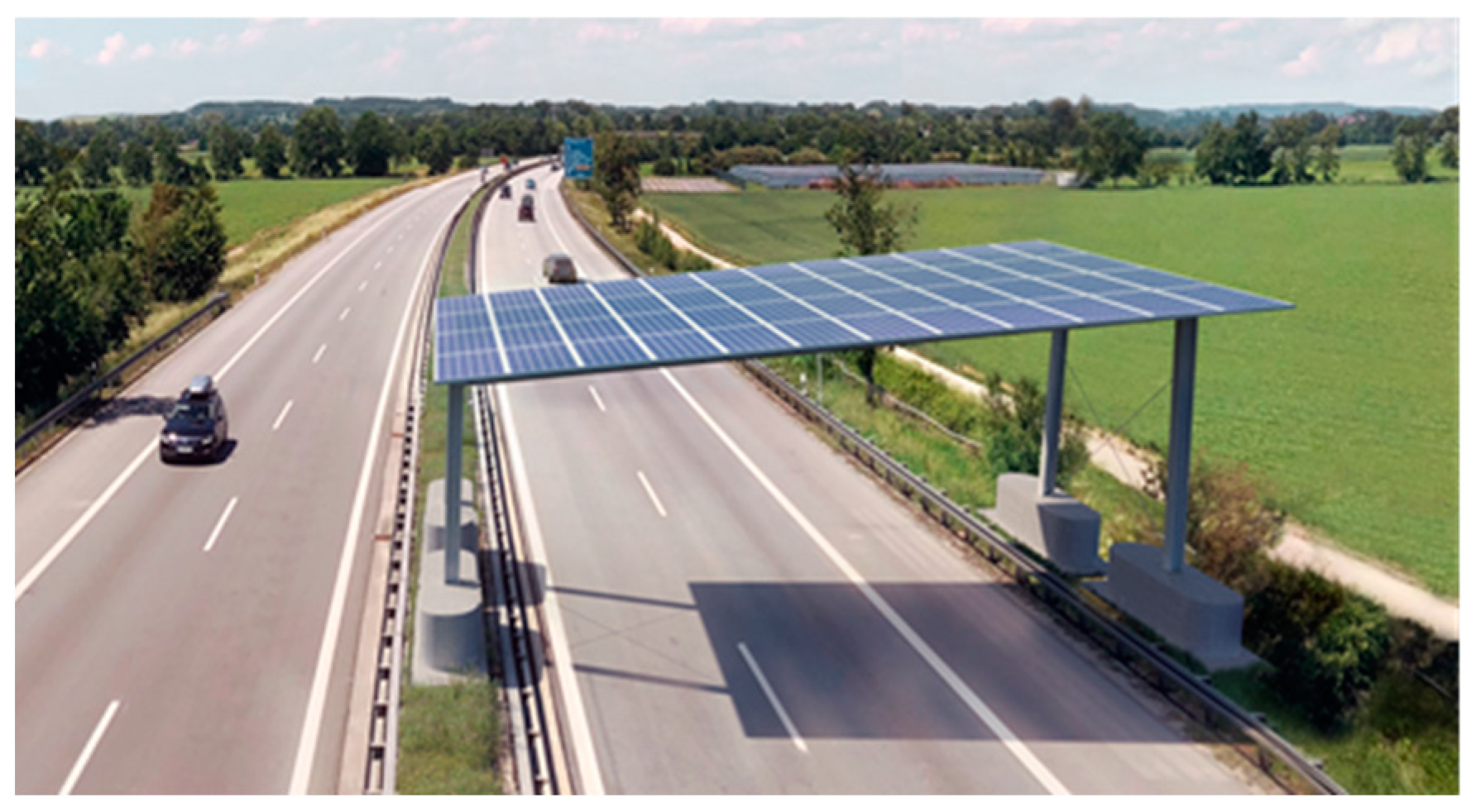
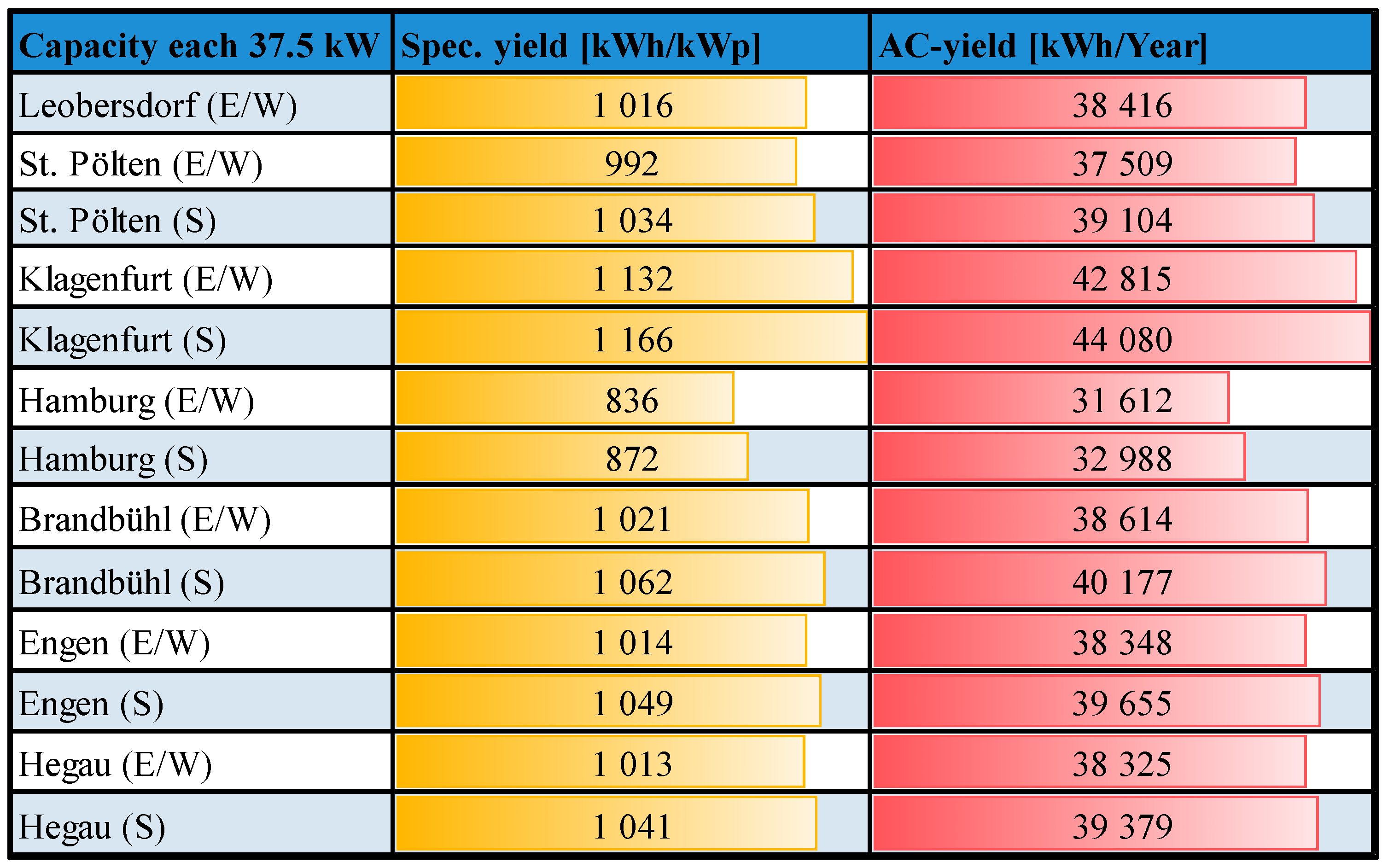
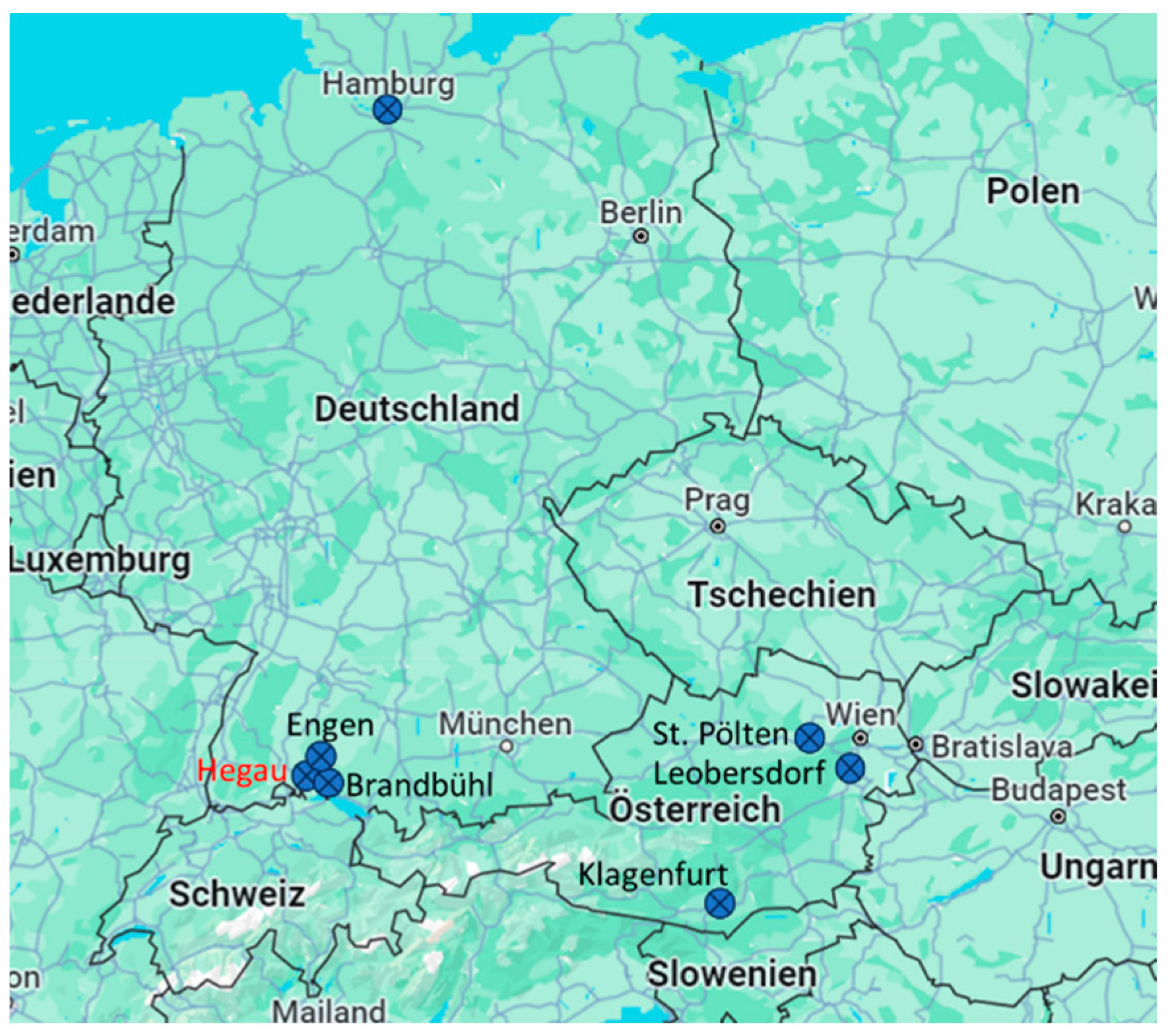


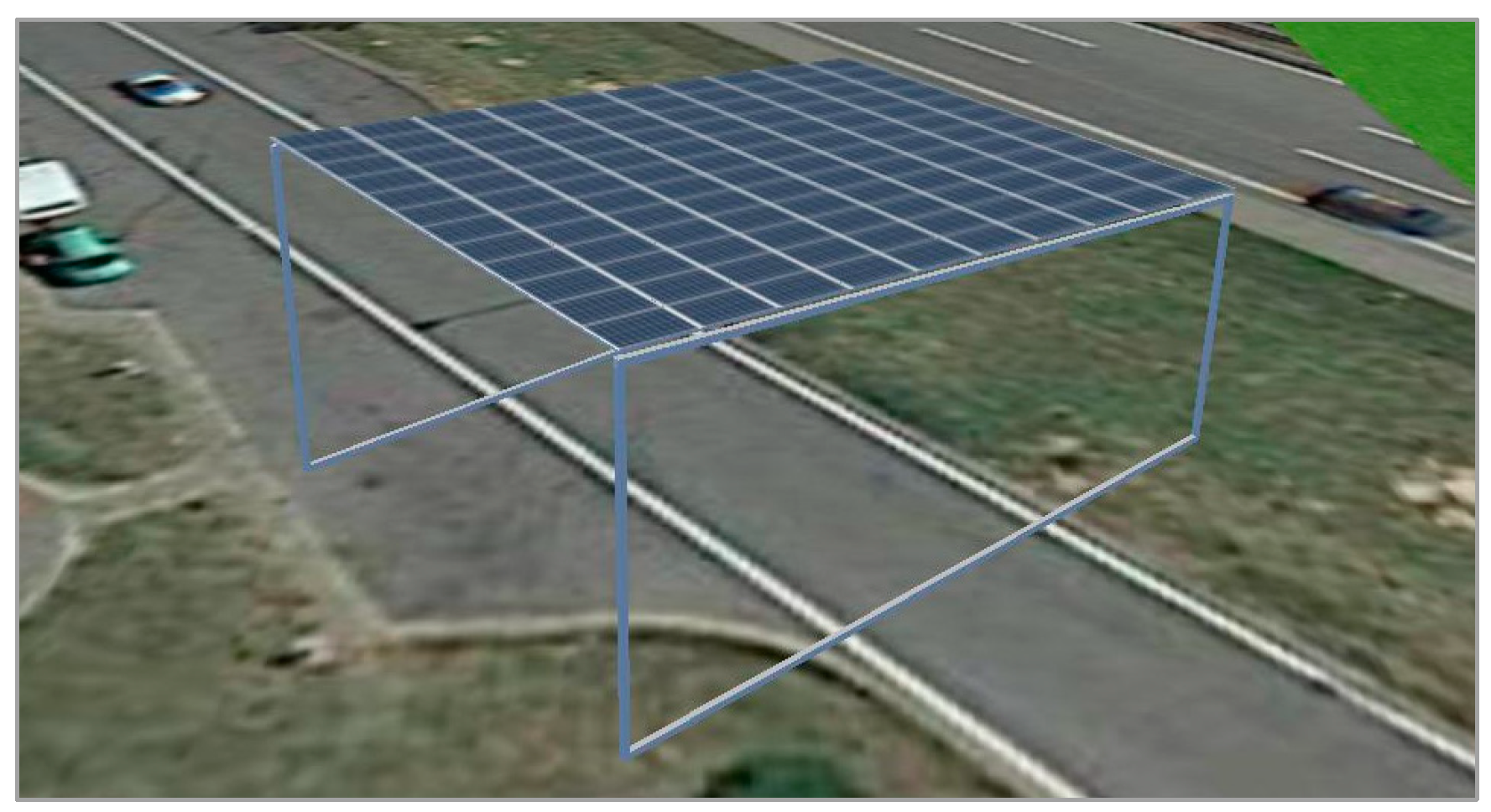

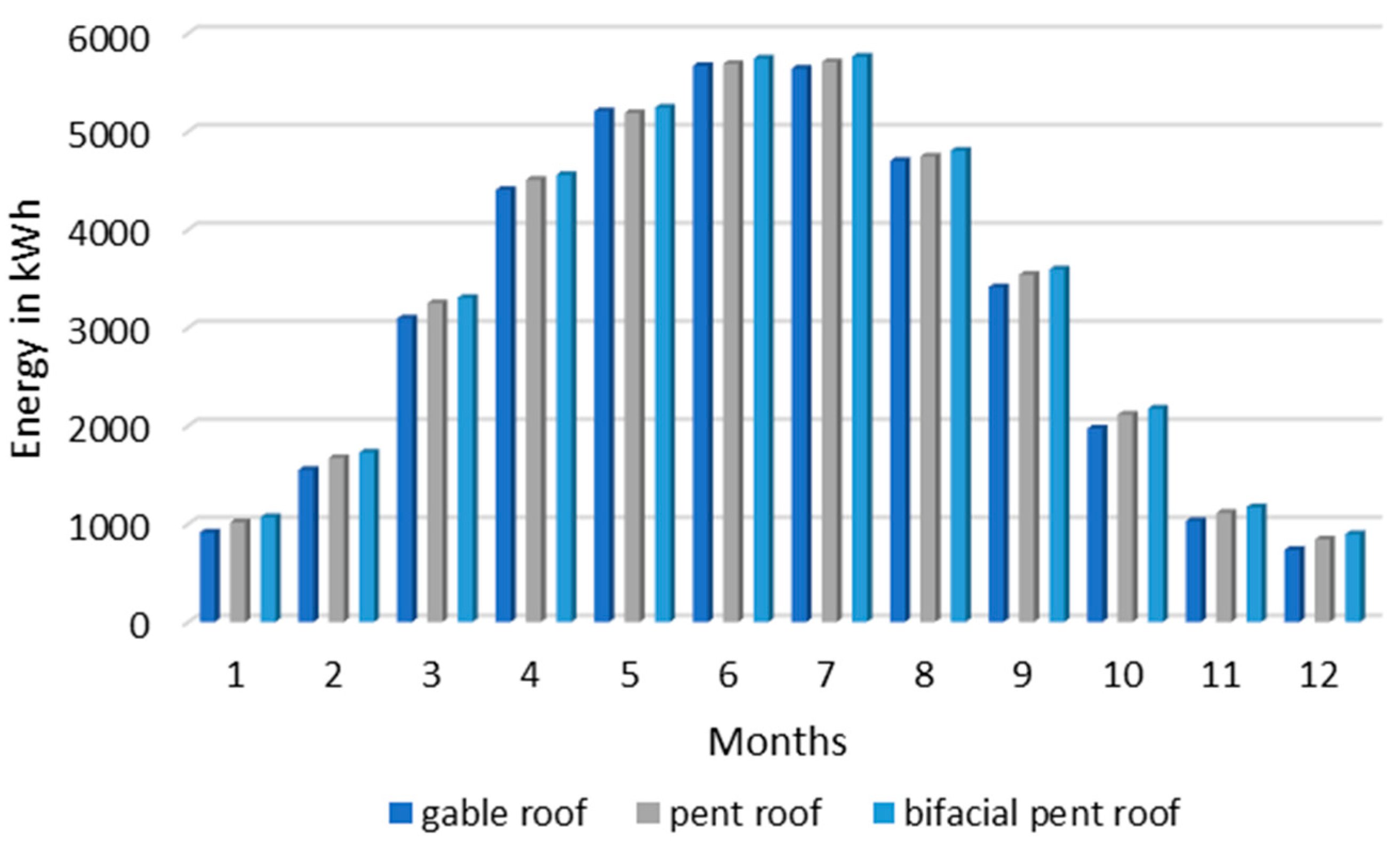
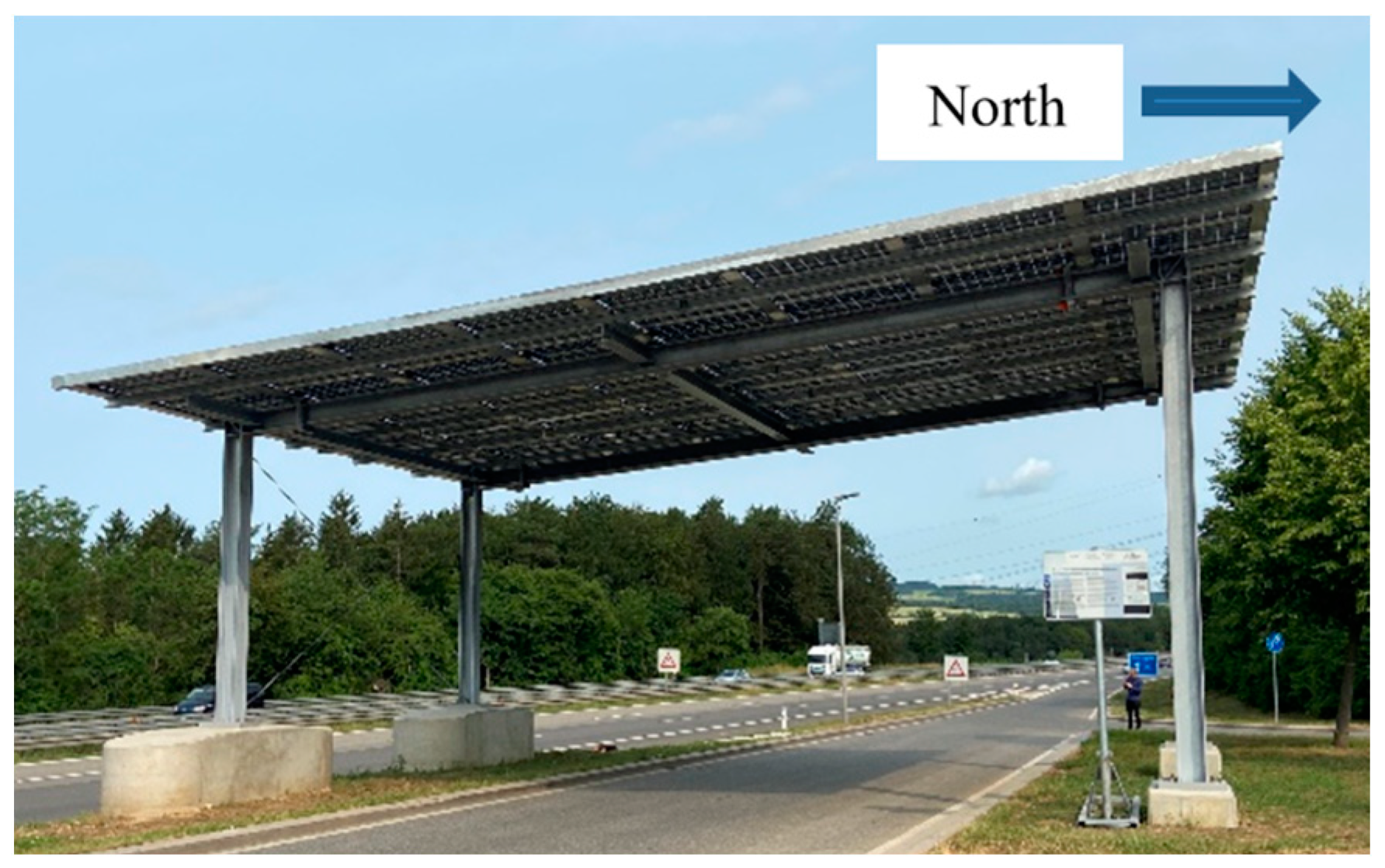
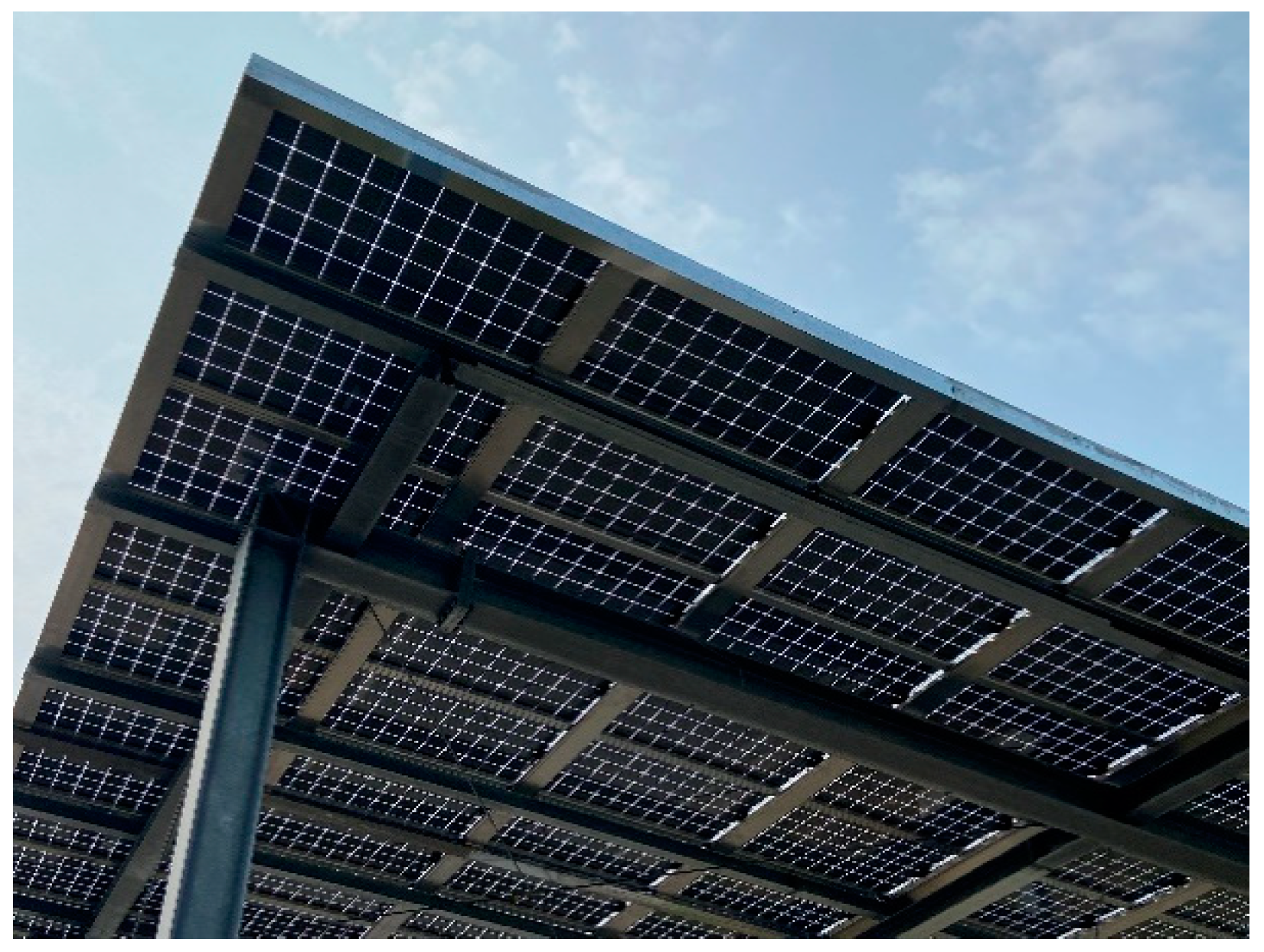
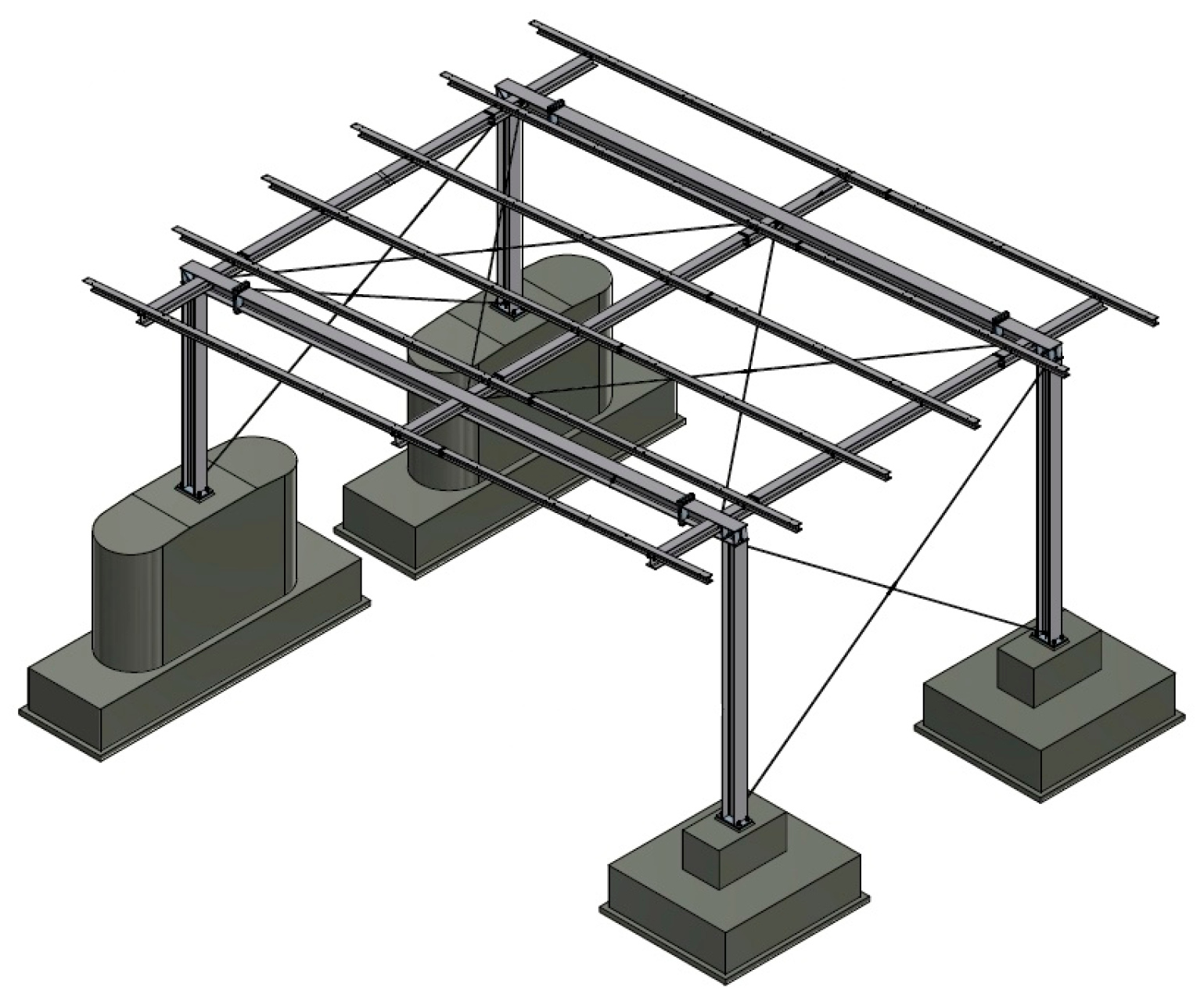
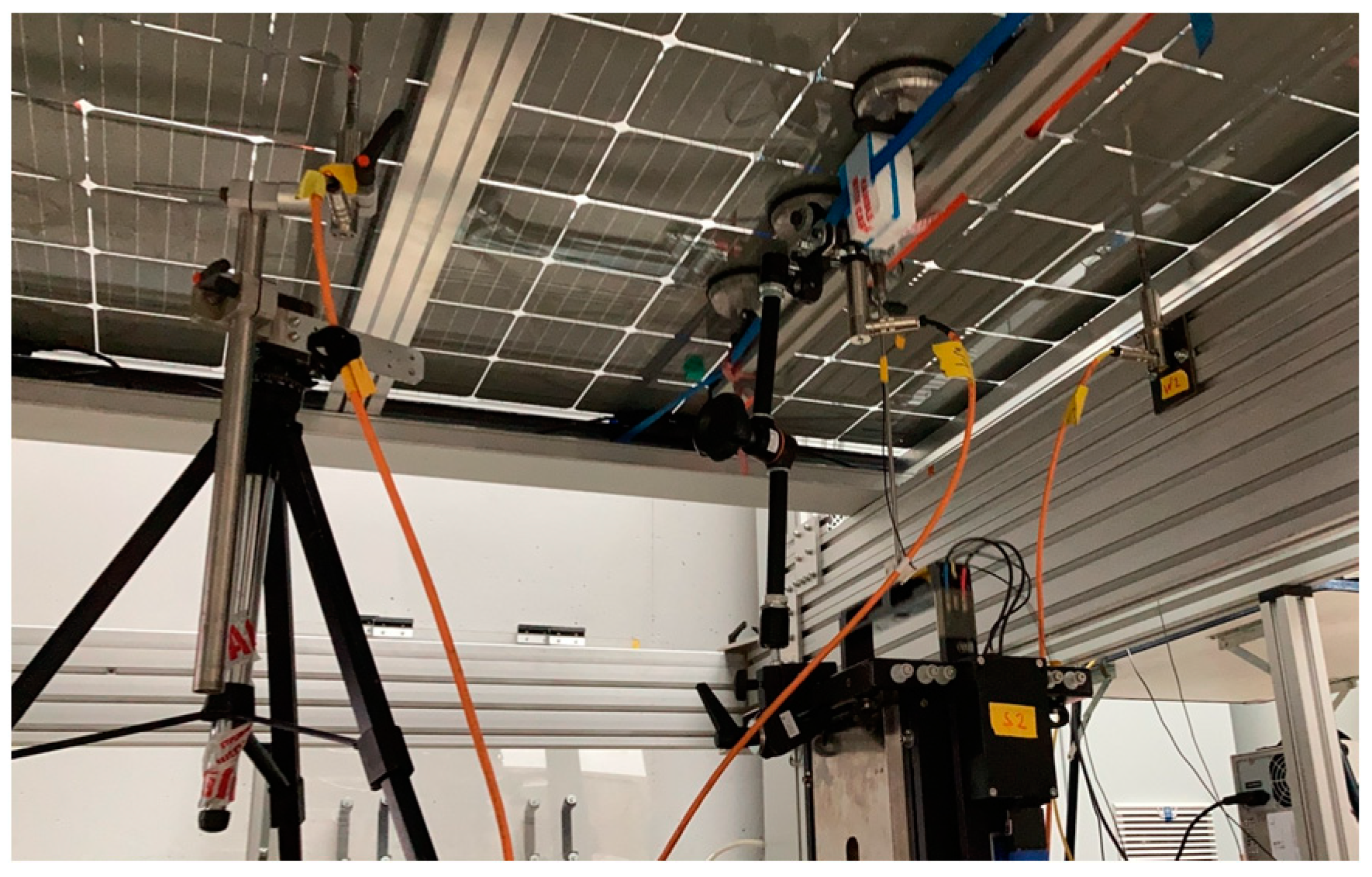
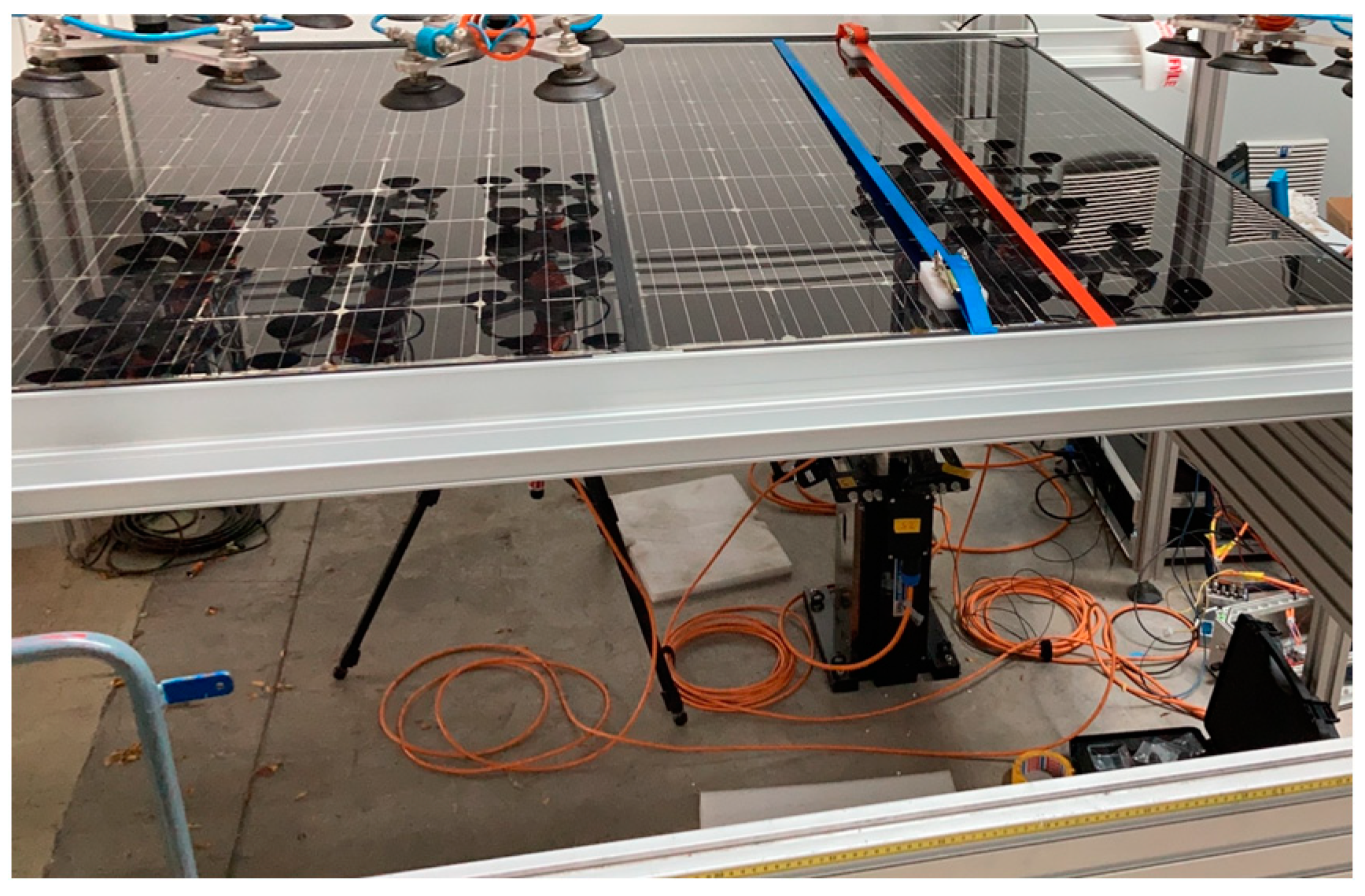
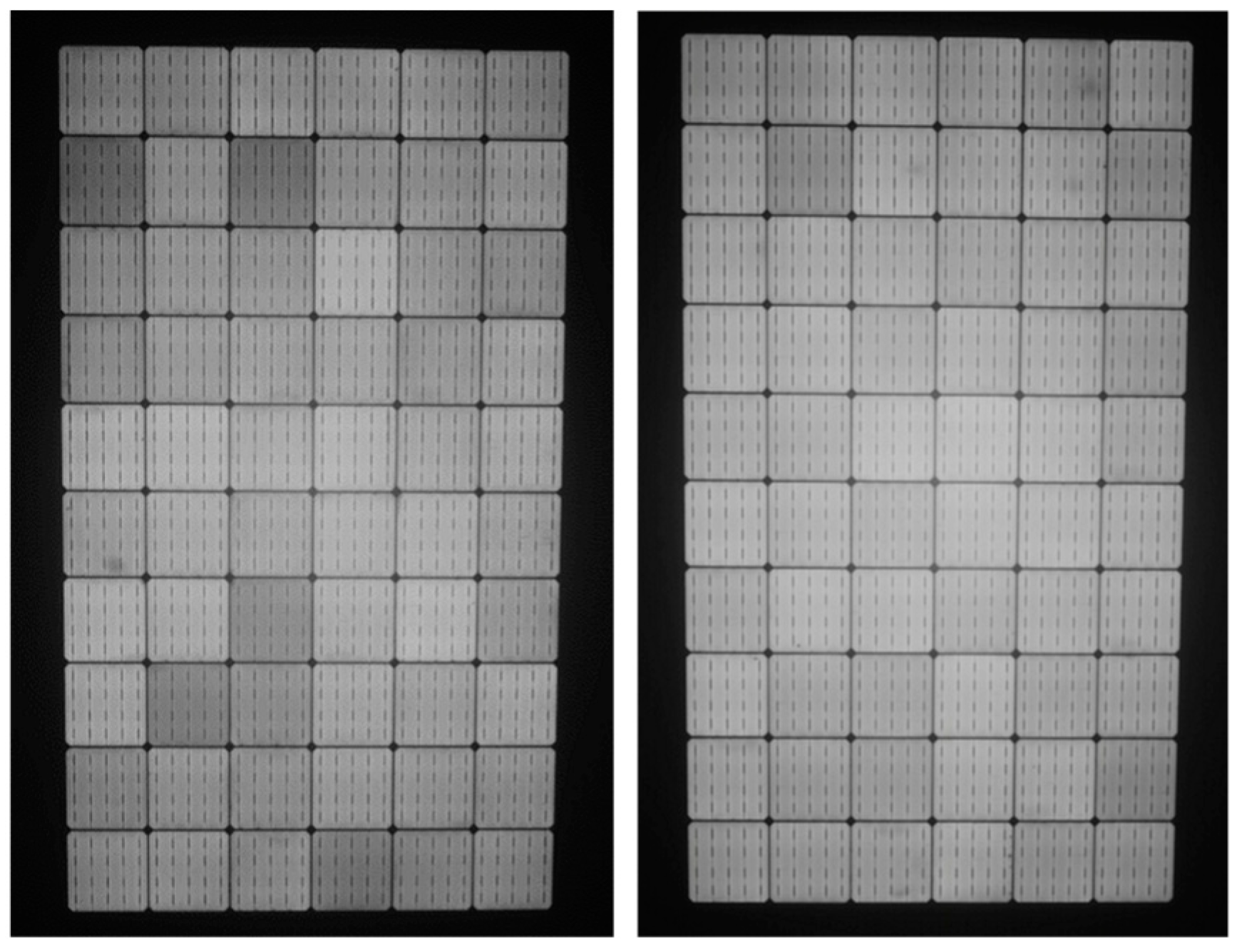
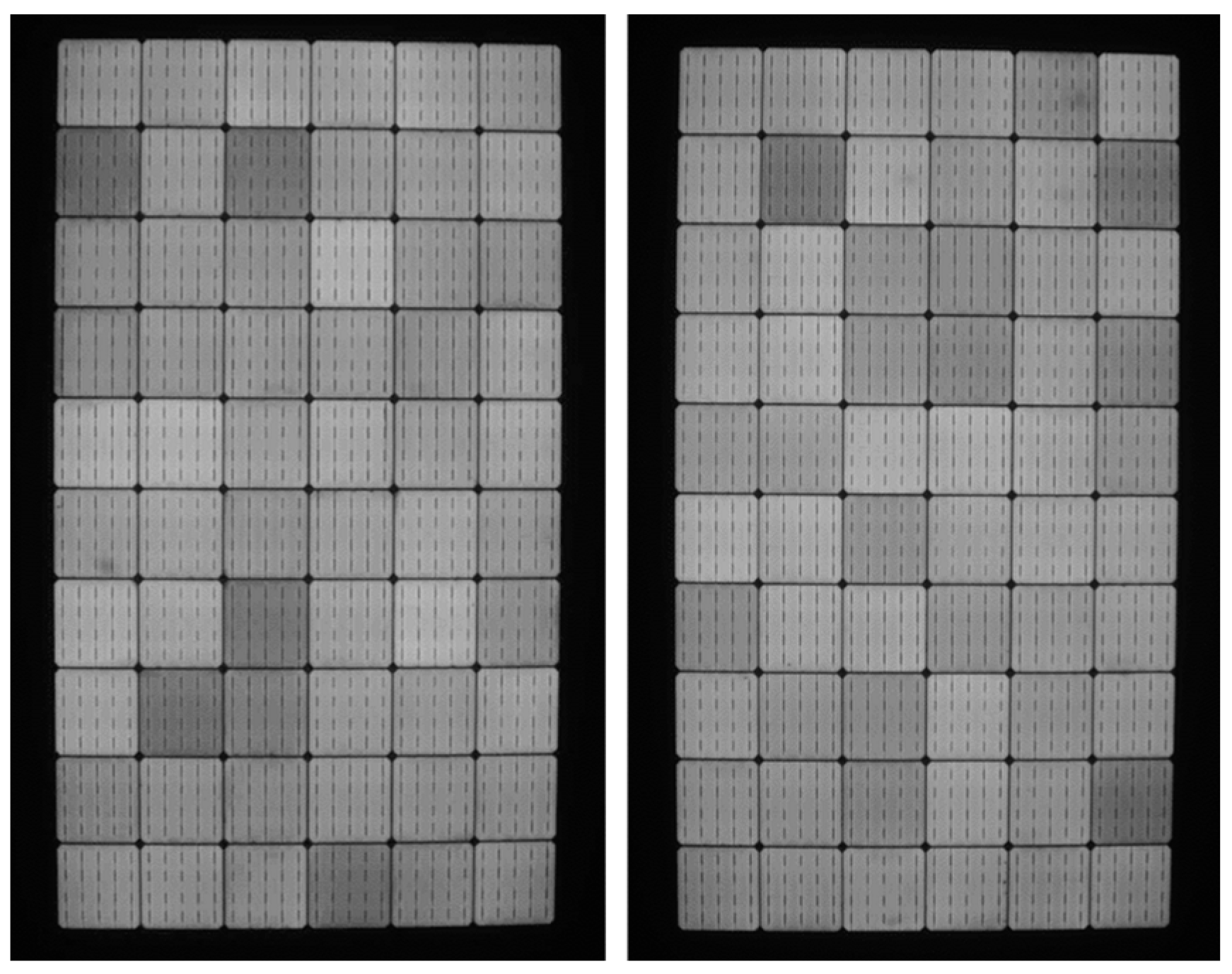
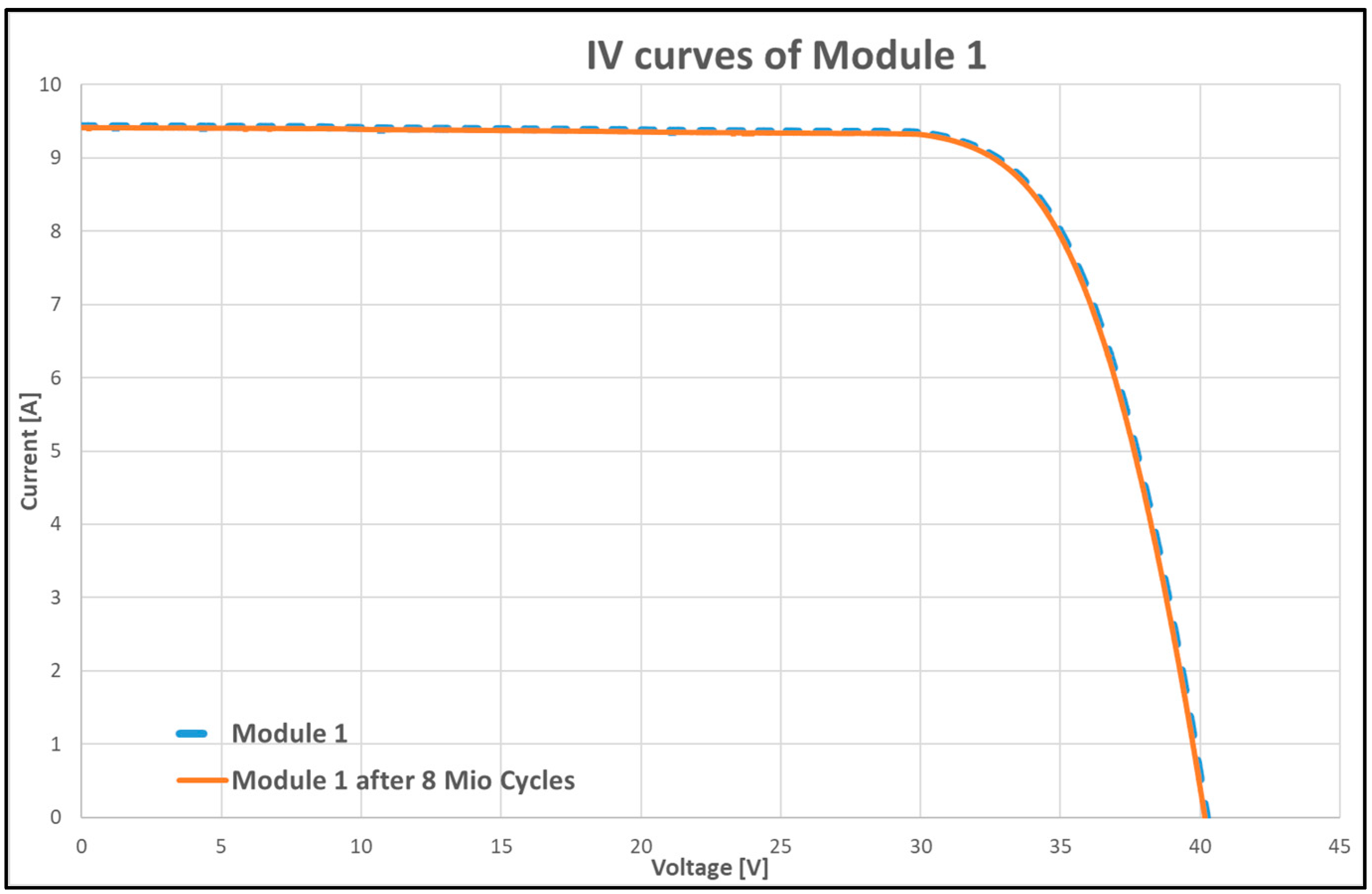
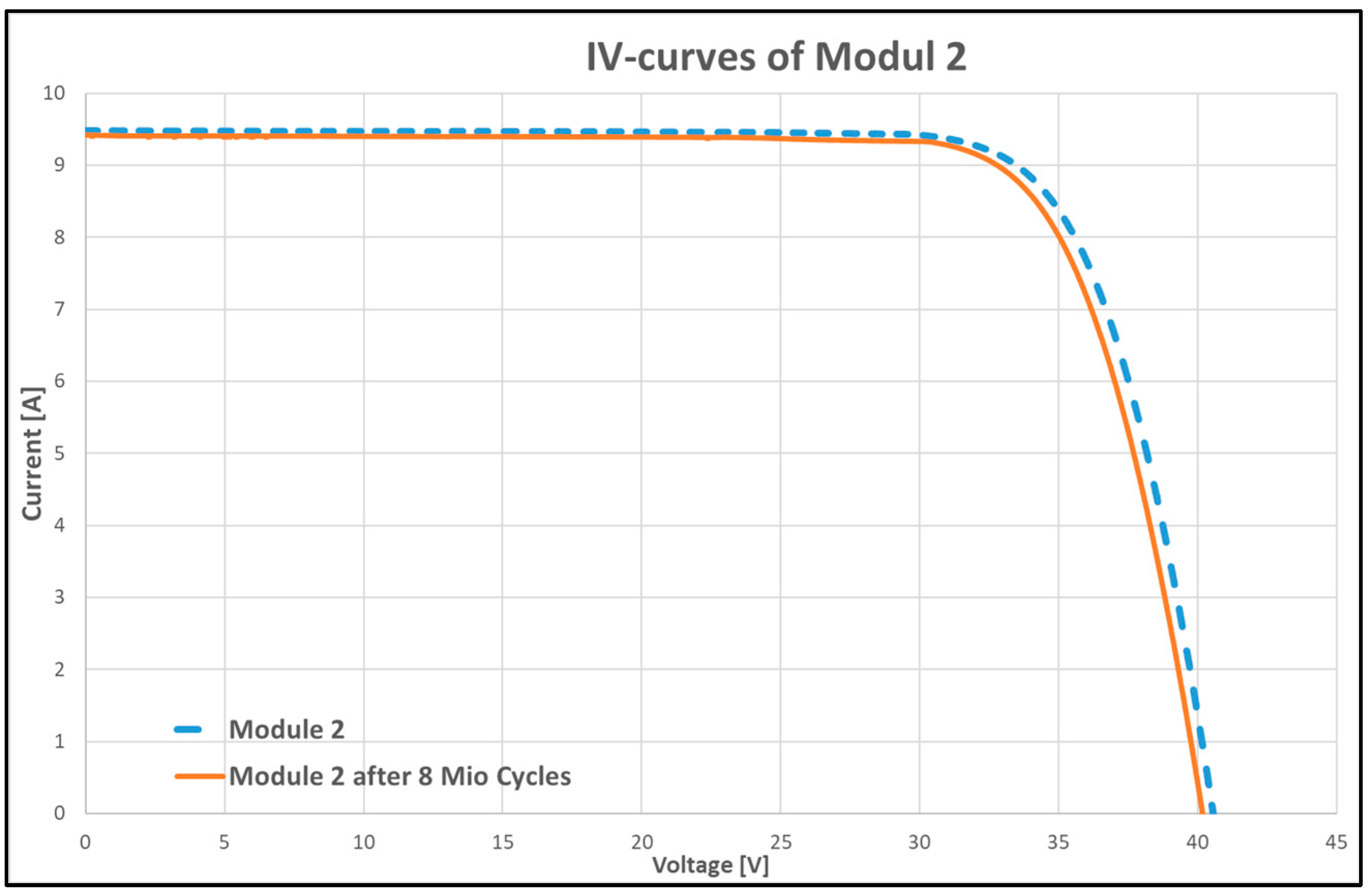
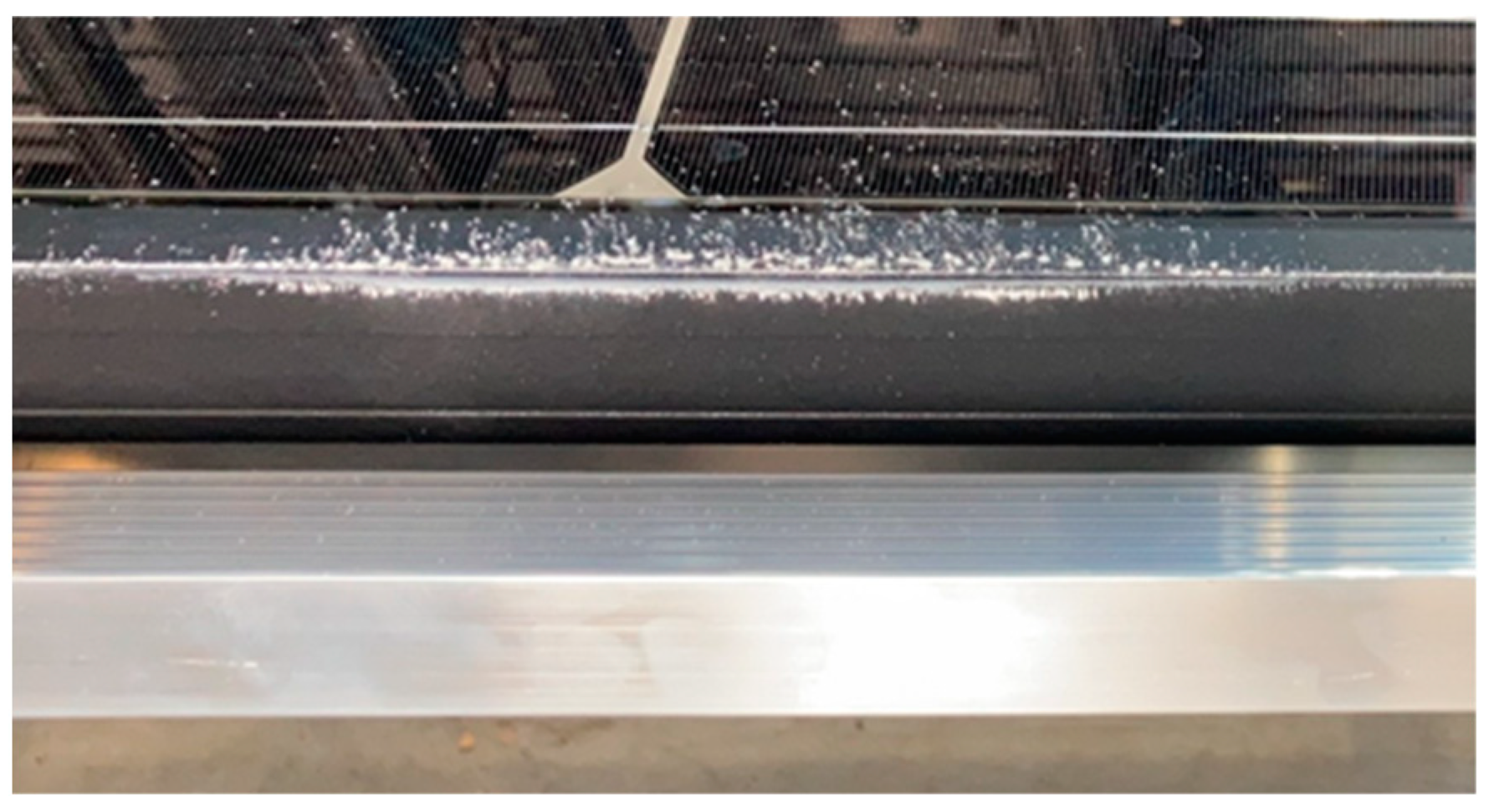
| Component | Techn. Data | Unit |
|---|---|---|
| Structure | ca. 10 × 17 | m, L × W |
| PV generator | 11.88 × 16.8 | m, L × W |
| PV area | 199.6 | m2 |
| No. modules | 120 | # |
| Power p. module | 315 | Wp |
| PV nominal power | 37.8 | kWp |
| Inclination | 5 | ° |
| Inverter, 3-phase | 2 × 17.5 | kW AC |
| A81 Hegau (Engen) 47.82292° N, 8.785754° E | Gable Roof | Pent Roof | Unit | |
|---|---|---|---|---|
| Monofacial | Bifacial | |||
| PV Generator Output | 37.8 | 37.8 | 37.8 | kWp |
| Generator Surface | 199.6 | 199.6 | 201.8 | m2 |
| Number of Modules | 120 | 120 | 120 | Quantity |
| Module | 60 cells Module size: 1680 mm × 990 mm | 60 cells Module size: 1680 mm × 990 mm | 60 cells Module size: 1682 mm × 1000 mm | |
| Annual Yield | 1013.31 | 1041.17 | 1058.89 | kWh/kWp |
| Performance Ratio | 87.8 | 88.0 | 89.8 | % |
| Grid Feed-in | 38 326 | 39 379 | 40 048 | kWh/year |
| Electrical Module Data (STC) | Value/Unit |
|---|---|
| Nominal power | 315 W |
| Nominal voltage | 33.3 V |
| Nominal current | 9.5 A |
| Open circuit voltage | 41.1 V |
| Short circuit current | 9.95 A |
| Module efficiency | 19.1% |
| Inverter Data | Value/Unit |
|---|---|
| Max input current | 47.7 A |
| Number of MPP trackers | 1 |
| Max PV generator output | 37.8 kWp |
| Max efficiency | 98.3% |
| Dimensions (h × w × d) | 725 × 510 × 225 mm |
| Weight | 37.7 kg |
| After Vibration | Pmax | Voc | Isc | FF |
|---|---|---|---|---|
| Module 1 | −0.4% | −0.2% | −0.2% | −0.0% |
| Module 2 | −2.0% | −1.4% | −0.7% | −0.4% |
Disclaimer/Publisher’s Note: The statements, opinions and data contained in all publications are solely those of the individual author(s) and contributor(s) and not of MDPI and/or the editor(s). MDPI and/or the editor(s) disclaim responsibility for any injury to people or property resulting from any ideas, methods, instructions, or products referred to in the content. |
© 2024 by the authors. Licensee MDPI, Basel, Switzerland. This article is an open access article distributed under the terms and conditions of the Creative Commons Attribution (CC BY) license (https://creativecommons.org/licenses/by/4.0/).
Share and Cite
Ebner, R.; Mayr, C.; Rennhofer, M.; Berger, K.A.; Heinrich, M.; Basler, F.; Beinert, A.J.; Huyeng, J.D.; Haider, M.; Prammer, D.; et al. Photovoltaic Roofing for Motorways and Other High-Ranking Road Networks: Technical Feasibility, Yield Estimation, and Final Demonstrator. Energies 2024, 17, 3991. https://doi.org/10.3390/en17163991
Ebner R, Mayr C, Rennhofer M, Berger KA, Heinrich M, Basler F, Beinert AJ, Huyeng JD, Haider M, Prammer D, et al. Photovoltaic Roofing for Motorways and Other High-Ranking Road Networks: Technical Feasibility, Yield Estimation, and Final Demonstrator. Energies. 2024; 17(16):3991. https://doi.org/10.3390/en17163991
Chicago/Turabian StyleEbner, Rita, Christoph Mayr, Marcus Rennhofer, Karl A. Berger, Martin Heinrich, Felix Basler, Andreas J. Beinert, Jonas D. Huyeng, Manfred Haider, Dominik Prammer, and et al. 2024. "Photovoltaic Roofing for Motorways and Other High-Ranking Road Networks: Technical Feasibility, Yield Estimation, and Final Demonstrator" Energies 17, no. 16: 3991. https://doi.org/10.3390/en17163991
APA StyleEbner, R., Mayr, C., Rennhofer, M., Berger, K. A., Heinrich, M., Basler, F., Beinert, A. J., Huyeng, J. D., Haider, M., Prammer, D., Vorwagner, A., Fehringer, M., & Beck, T. (2024). Photovoltaic Roofing for Motorways and Other High-Ranking Road Networks: Technical Feasibility, Yield Estimation, and Final Demonstrator. Energies, 17(16), 3991. https://doi.org/10.3390/en17163991






